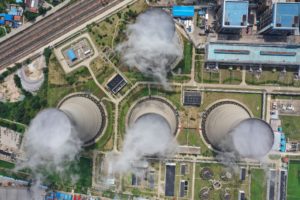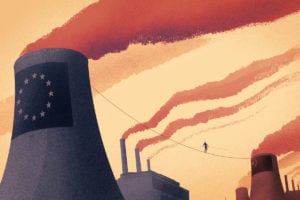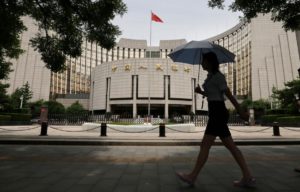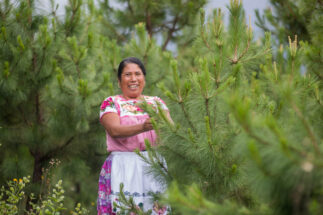Carbon market players are watching closely to see how China’s version of carbon credits, the China Certified Emission Reductions (CCER) scheme, will be rebooted.
Like carbon allowances, carbon credits are a tradeable item. They are essential for the operation of carbon markets and carbon pricing because they make profit possible via buying and selling.
China’s national carbon market opened in July last year, and the first implementation period for allowance trading is already complete. However, market players eager to see the CCER scheme up and running again are still waiting.
This article looks at the scheme’s history and explores some of the opportunities and challenges linked to bringing it back.
Why China set up its domestic carbon credit market
China’s targets to peak emissions before 2030 and reach net zero before 2060 have brought the attention of more Chinese people to carbon markets and the profit-making opportunities they provide. While the national carbon market is new, many don’t realise that China has already been running such trading platforms for over 10 years. The country started issuing CCERs in 2012 before suddenly halting them in 2017.
CCERs are China’s version of the Kyoto Protocol’s Certified Emission Reduction or CER – a carbon credit that can be traded under the protocol’s Clean Development Mechanism. A typical carbon market is made up of trading in both carbon allowances and carbon credits. Allowances, also known as quotas, limit the emissions a company can make: what the company does not use of these allowances, it can sell. Meanwhile, credits are earned by a broader range of economic actors for reducing emissions. Activities to reduce emissions can be profitable because credits can be sold on carbon markets.
In 1997, the Kyoto Protocol established the first three international carbon-trading mechanisms: Joint Implementation (JI) projects, Emissions Trading (ET) and the Clean Development Mechanism (CDM). Following on from the CDM, several parallel carbon credit standards appeared, including the Voluntary Carbon Standard (now called the Verified Carbon Standard) and the Gold Standard, each corresponding to different trading systems. These competed globally. In 2009, China’s Beijing Environment Exchange proposed the Panda Standard at the Copenhagen climate talks.
China’s first experience of carbon trading was under the CDM, which saw developing nations sell carbon emission credits to the developed world. The first of China’s CDM projects was the Huitengxile wind farm in Inner Mongolia, registered in June 2005. But since June 2017, when the Beijing Haidian Beibu gas-fired cogeneration project was registered, China has seen no new CDM projects.
Development and trading of CDM projects in China peaked between 2007 and 2009, with a top price of 30 euros per tonne of carbon. In comparison, trading on China’s regional trial carbon markets was at around 20 yuan a tonne, while the price on the new national market has held steady at about 50 yuan a tonne. Good carbon prices caused a boom in CDM projects, with 1,478 Chinese projects registered from June 2005 to June 2017, producing 900 million tonnes of carbon assets and trading worth hundreds of millions of dollars. Figures from the World Bank show that over 18,000 carbon credit projects were registered between 2002 and 2020, covering 4.3 billion tonnes of carbon. Half of those were under the CDM system, the remainder under other international standards.
One of the reasons for the drop in CDM projects was that in 2009 China announced its own climate action targets for the first time. These required domestic emissions reduction mechanisms and marked the start of a domestic market in carbon credits. In 2012, the National Development and Reform Commission (NDRC) set up the framework for CCER markets, issuing documents on project certification and trading in greenhouse gas reductions.
The missing piece in the carbon market
In 2013, and to great fanfare, China launched seven regional carbon market trials, with each trying different approaches. As CCERs could be offset against carbon allowances or traded on the market, corporate groups with renewable energy interests set up carbon asset firms. There was a wave of innovation in low-carbon business ideas. One example was “carbon sink fisheries” – the theory that commercial marine aquaculture of kelp, shellfish and even fish can create viable carbon sinks – of which several trials were soon up and running.
Between 2012 and 2017, the carbon price on regional exchanges ranged from 10 to 40 yuan a tonne, with most at around 20 yuan. CCER prices were linked with allowance prices. But the regional markets couldn’t play a full role in price discovery because they were fragmented and had small trading volumes, so the carbon price remained low. As the number of CCER projects grew, unhealthy competition on price became a problem. In March 2017, the NDRC announced that due to low trading levels and irregularities in some projects, no new CCER projects would be approved, although existing projects would continue to trade.
According to data from Refinitiv Carbon Research, the State Council approved 80 million tonnes worth of CCERs between 2012 and 2017, but only 32 million tonnes were sold. The glut kept carbon prices low, industry lost interest, and the oversupply of carbon assets got worse.
But credits are essential for a complete carbon market. To stimulate emissions cuts and help China achieve its dual carbon targets, more market actors need to get involved, not just those receiving carbon allowances. But they will only do so if there is profit to be made, hence the need for carbon credits such as CCERs, which they can sell. So, everyone is watching for when and how the CCER scheme may restart.
Getting ready for the reboot
In 2018, responsibility for combatting climate change shifted from the NDRC to the Ministry of Ecology and Environment (MEE). In February this year, reports appeared that the MEE was expected to support the city of Beijing in setting up a national CCER market. Work to develop a CCER trading system is almost complete and industry rumour was that it would start operating in the first half of 2022. Allowances for China’s 2021 national carbon market were not in short supply, but there was still an appetite for CCERs. By early 2022, CCERs were trading at about 45 yuan a tonne. But in the spot market, CCERs were in short supply, and negotiations focused on carbon futures for the year after CCER restarted. This indicates strong demand for CCERs, but little supply.
Under current rules, CCERs can cover up to 5% of compliance obligations. During the first implementation period of the national carbon market, firms covered by the rules used 33 million tonnes worth of CCERs in this way, more than the total for 2012–2017. According to the Refinitiv data mentioned above, there were around 40 million tonnes of CCERs on the market when approvals were halted in 2017, but the bulk of those have now been used.
In the almost 11 months since the national market started, policymakers have borne in mind lessons learned from over-supply and made adjustments to avoid this happening again.
Globally, the sectors earning carbon credits are usually forestry, agriculture, carbon capture and storage, energy efficiency, fuel transitions, fugitive emissions, industrial gases, manufacturing, renewable energy, and transportation, with forestry being the most common.
In September 2021, the General Office of the Chinese Communist Party and the General Office of the State Council issued a document on reforms to ecological compensation mechanisms, shrinking the range of CCER projects to three core areas: forestry, renewable energy and methane utilisation. That document has had a far-reaching impact on the market’s expectations for CCERs and investment choices. It signals that policymakers want to see high-quality CCER projects and avoid another over-supply. These areas are also key concerns for China as it moves toward its dual carbon targets: renewable energy is the foundation of a new electricity system; forestry is the most typical carbon sink, and China has targets on forest stock to meet; while methane utilisation will be necessary for China’s vast agricultural sector and to help the natural gas industry move in a greener direction.
Meanwhile, the status of CCERs as multi-purpose financial assets has been strengthened. In July 2021, the People’s Bank of China’s standard for environmental equity financing tools (JR/T 0228-2021) came into force, backing the market trading of CCERs and other environmental assets. And on 12 April this year, the China Securities Regulatory Commission issued JR/T 0244-2022 on carbon financial products, setting out implementation processes for typical carbon finance products. Carbon credits are more financial in nature when compared with carbon allowances and can support the development and circulation of more derivative products. A more active carbon financial market, with a wider range of products, will attract more capital and positive feedback into the primary carbon emissions market. Those newly issued standards are part of the financial sector’s preparations for the return of the CCER scheme.
Challenges ahead
Preparations may seem complete, but some challenges have worsened over the last five years.
First, there have been significant changes in the renewables sector, a major part of the CCER scheme. Current CCER methodology requires projects to prove “additionality” in their emissions reduction: the project should not be profitable or would not obtain financing without the sale of carbon credits. But in 2021, subsidies for sales of renewable energy in China were ended. In other words, the sector is now, in general, profitable. That leaves a question mark over the additionality of its emissions reductions. Ordinary renewable energy projects will therefore not necessarily qualify as CCER-suitable, meaning the CCERs which could potentially be provided by large numbers of proposed renewable projects may not materialise. With CCER status restricted to projects in the renewables, forestry and methane sectors, we may see shortages as the market expands.
Fortunately, in February, the city of Shanghai reduced the default emission factor – the coefficient for calculating emissions when real-time monitoring is not possible – for purchased electricity and heat, while in March the MEE reduced the emission factor for the national grid. Those changes reflect reduced emissions in the energy system as a whole. If mechanisms for dynamic adjustments to emissions factors can be implemented, demand for CCERs will hold steady, reducing concerns about supply and demand problems.
Another issue is the quality of reported emissions data. In 2021, Inner Mongolia’s environmental authorities exposed a typical case of fraudulent reporting. And in early 2022, the MEE reported on another four cases. It is rare for a light to be shined on the third-party service providers calculating and reporting on emissions in this way. Some of those firms will massage data for their customers’ benefit. The problem is linked to fierce price competition for carbon-consulting businesses. In response, the MEE has called for a crackdown, launching an initiative to oversee and improve the quality of carbon emissions reporting in the power sector, with working groups spending ten days or more inspecting each of 264 power firms across ten key cities. The fact that a central government ministry felt the need to intervene directly at the corporate level indicates how serious the problem is. Work to oversee and improve emissions reporting is set to continue. A review of data from the previous two years is also underway.
Alongside those two issues, many energy firms are calling for pricing mechanisms for “green electricity” – generated from renewables, currently only solar and wind, to be expanded to include hydro, but unlikely to include nuclear – and carbon to be combined in a single system. Power and carbon are closely linked, yet in practice, they have separate pricing mechanisms and markets, and prices for both assets are disconnected. In guidelines for emissions reporting in some sectors, green electricity from renewable sources cannot be deducted from total power use. That means covered businesses which opt to buy green electricity end up bearing extra costs – which naturally makes them less likely to do so. It is also more expensive to run two markets than one, increasing overall social and economic costs.
There are signals that the CCER scheme is about to return. Since it was halted last year, policymakers have approached defining the future CCER project pool cautiously but have still sent some clear signals. The market has been attentive and responsive to those signals, and there is already pent-up demand – if not a land rush – in CCER investments and financing. It remains unclear when CCER approvals will restart, but the authorities and market actors have a rough sketch of the rules and prices.
And now, the stock of CCERs has been significantly consumed, and some experience with carbon allowances trading has been acquired. Clear warnings have also been sent about the importance of data quality. The national market presents new challenges for the CCER scheme, but everyone is keen to see it return.
All that remains is to wait and prepare.








